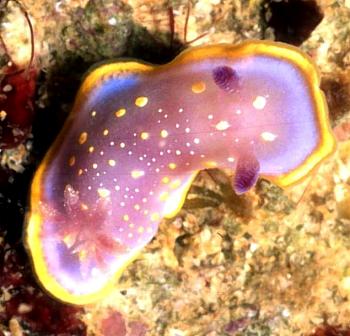
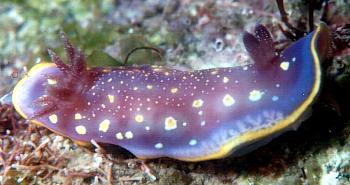
Chromodoris luteopunctata
(Gantès, 1962)
Order: NUDIBRANCHIA
Suborder: DORIDINA
Superfamily: EUDORIDOIDEA
Family: Chromodorididae
DISTRIBUTION
Gibraltar Straits area, North Africa, Canary Islands, Senegal.
PHOTO
UPPER: Trafalgar, southern Spain. PHOTO: Terry Gosliner.
LOWER: Bay of Algeciras (Strait of Gibraltar, Southern Spain). Size: 30 mm., Depth: 22 m. Date: July 2000. PHOTOS: Alma Sánchez
Chromodoris luteopunctata (Gantès, 1962), originally described from Morocco, is very similar to Chromodoris luteorosea. It is known from the Gibraltar Straits area, North Africa, and the Canary Islands. It is reported on the Forum from Senegal.
The body and mantle are translucent violet, with some darker zones on the mantle. There is a broad yellow band around the mantle edge, inside of which is a thin brownish red zone, and inside this a broad bluish band. The reddish zone seems to be caused by the overlapping of the yellow and violet pigments and the broad inner bluish band is caused by the underlying opaque white mantle glands being obscured by the violet pigmentation of the mantle skin. The blue band then varies from animal to animal depending on the development of the mantle glands. The mantle is covered with scattered opaque white and yellow spots of varying sizes. Usually the inner ones are small and white and the outer ones larger and yellow. But sometimes there are small yellow spots, or large white spots with a yellow centre. Smaller specimens usually have less violet pigmentation and so appear a translucent violet-grey. In small specimens the mantle glands are less obscured and so their reticulate, branching nature is more obvious than in larger animals [see lower photo]. The body is translucent violet with small whitish spots. There is a thin opaque white line around the anterior part edge of the foot which thickens about halfway down the foot. The rhinophores are reddish-violet, darker towards the tip, but with a translucent white tip. The lamellae on the rhinophore club have small bluish white spots in adults, but these are absent in juveniles. The gills are similar in colour to the body, and have the same small whitish spots found on the rhinophores.
The small white spots on the gills and rhinophores have previously been considered a good charcter separating this species from C. luteorosea, but there are many photos on the Forum showing similar spots in specimens of that species. The shape, size and colour of the spots on the mantle has also been used to separate these two species. C. luteopunctata is said to have small, irregular yellow spots in the center of the mantle, and larger spots on the mantle margin. But often the small spots are white and the larger spots are white with a yellow centre. C. luteorosea on the other hand has a fairly even scattering of large spots [white with yellow centre] interspersed with a few small white or yellow spots. The only consistent difference seems to be that in C. luteorosea large spots have a smooth round edge while in C. luteopunctata the edge of larger spots is very irregular [See Alma Sanchez's message].
See message comparing this with C. luteorosea.
See message comparing it with C. rodomaculata.
Reference:
• Cervera, J. L., Garcia Gomez, J.C. & Ortea, J.A. (1989) On two rare chromodorid nudibranchs (Opisthobranchia: Chromodorididae) from the Eastern Atlantic, with the description of a new species of Glossodoris. Journal of Molluscan Studies, 55: 445-453.
Rudman, W.B., 2003 (June 26) Chromodoris luteopunctata (Gantès, 1962). [In] Sea Slug Forum. Australian Museum, Sydney. Available from http://www.seaslugforum.net/find/chroluteop
Related messages
Chromodoris luteopunctata from Senegal (eggs)
July 4, 2003
From: M. Poddubetskaia
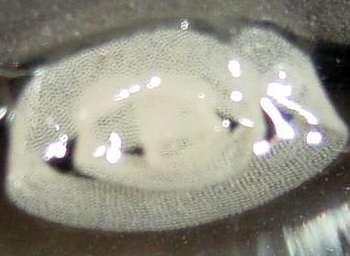
Dear Bill,
To complete my last message on Chromodoris luteopunctata from Dakar, here is an egg-ribbon which was laid by one of animals in my tank. I forgot to send you it previously.
The photo isn't great because these eggs were laid in 'bad' place, just at the water level and so difficult to photograph.
Size : 15-20mm in diameter.
Photos: Marina Poddubetskaia - Nembro website
Cheers,
Marina.
nembro@nembro.info
Thanks Marina,
A less than perfect photo is much better then no photo! Slugs often lay their eggs in the most impossible places for photography. This photo is a valuable addition to our knowledge of the species
Best wishes,
Bill Rudman
Chromodoris luteopunctata from Senegal
June 28, 2003
From: Marina Poddubetskaia
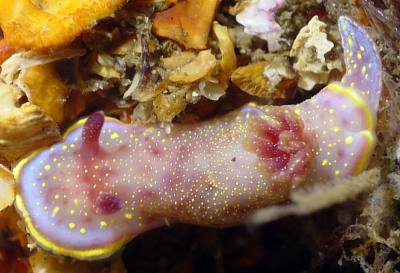
Dear Bill,
Concerning your comments on Chromodoris luteorosea. Luckily I also have photos of Chromodoris luteopunctata from Dakar. This species is quite common there and this ID was confirmed by Lucas Cervera. I hope these photos will help you to sort out the identification of previous animal.
Location: Dakar, Senegal, Eastern Atlantic
Site : Tacoma Wreck, Depth: 11m, Size: 25-30mm, May 26, 2003.
Photos: Marina Poddubetskaia - Nembro website
Best wishes,
Marina.
nembro@nembro.info
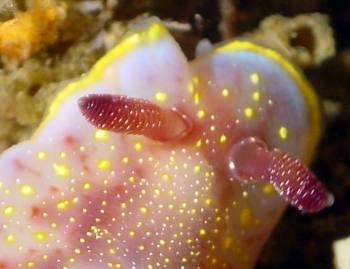
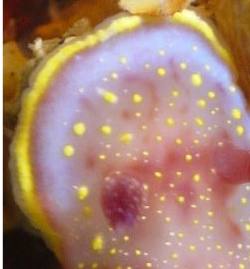
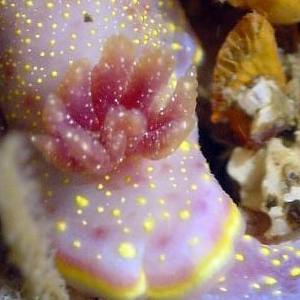
Dear Marina,
Thanks for these interesting photos. I think this is the first record of C. luteopunctata from the West African mainland. It certainly looks different from your earlier animal which I tentatively identified as Chromodoris luteorosea. My doubts were based on the opinions of local experts on the fauna who have written that the presence of white spots on the gills and rhinophores of C. luteopunctata, and their absence in C. luteorosea, are a good way to separate the two species. And yet your animals of both 'species' from Senegal all have white spots on the gills and rhinophores. The only consistent difference seems to be that in C. luteorosea large spots have a smooth round edge while in C. luteopunctata the edge of larger spots is very irregular [See Alma Sanchez's message].
Looking at published anatomical studies I can't see any major anatomical differences between the two species which could easily resolve the matter so I suspect we will need to learn something about their biology before we can be sure. Perhaps their egg masses, or development type is different or perhaps they feed on different sponges?
Chromodorids are great mimics of each other so we can't rule out that these are two species mimicking each other. However we need to find some way of ruling out that they are not just one variable species.
Best wishes,
Bill Rudman
